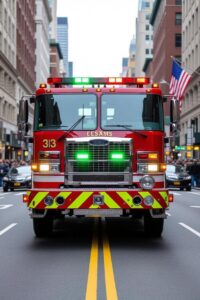Green Flashing Beacon Vehicle Light | Who Can Use Them
Recognizing and understanding the purpose of a green flashing beacon is essential for ensuring safety, awareness, and proper response in both everyday and emergency situations.
What’s A Green Flashing Beacon?
A green flashing beacon is a visual signal, typically used in specific contexts to convey information or warnings.
Unlike common explanations that focus on standard uses like emergency vehicles or aviation, let’s explore it from a fresh perspective, emphasizing its role as a universal attention-grabber and its psychological and practical implications, without leaning on typical blog content.
Imagine a green flashing beacon as a silent shout in a crowded room. Its pulsing green light cuts through visual noise because green is one of the most perceptible colors to the human eye, thanks to our evolutionary sensitivity to natural hues associated with life and safety. Unlike red (danger) or blue (calm or authority), green signals “notice me” with a sense of urgency but without the immediate alarm of red. It’s like a nudge rather than a shove.
In practical terms, green flashing beacons are versatile communicators. They’re often used in environments where immediate action is needed but not necessarily panic—think of a factory floor where a green beacon might signal a machine is ready for loading or a process has completed. It’s a call to engage, not to flee. In maritime settings, a green flashing light could mark a safe channel or a buoy, guiding vessels without implying imminent danger. Even in less conventional settings, like art installations or experimental tech, a green beacon might pulse to draw attention to an interactive element, leveraging its eye-catching rhythm.
The psychology behind it is key: the flashing pattern creates a sense of dynamism, pulling focus because our brains are wired to notice change. A steady light might blend into the background, but a green flash demands attention without overwhelming. It’s less aggressive than a siren but more insistent than a static glow.
This makes it ideal for scenarios where clarity and prompt response are needed without causing stress.
From a design standpoint, green flashing beacons are often chosen for their balance of visibility and energy efficiency. LEDs, commonly used for these beacons, emit green light at high intensity with low power draw, making them practical for long-term use in remote or battery-powered setups, like solar-powered markers in rural areas.
In a broader sense, think of a green flashing beacon as a bridge between human instinct and modern systems. It taps into our primal alertness to movement and color while serving highly technical purposes, from guiding a forklift driver to signaling a drone’s landing zone. It’s a small but powerful tool that speaks clearly in a world full of distractions.
Why Use A Green Flashing Beacon?

- Industrial Settings: Signals operational status on machinery, such as a green flash indicating a process is complete, a machine is ready for use, or a conveyor belt is clear for loading. It prompts workers to act without implying an emergency.
- Maritime Navigation: Marks safe channels, buoys, or starboard sides of vessels, guiding ships through waterways at night or in low visibility. The green flash distinguishes navigational aids from red danger markers.
- Aviation: Indicates safe zones on airfields, such as taxiway clearances or ground equipment staging areas, helping pilots and ground crews coordinate movements without confusion.
- Traffic and Road Safety: Used on slow-moving vehicles (e.g., agricultural machinery or maintenance trucks) to alert drivers of their presence, especially in rural or low-light conditions, signaling caution without urgency.
- Emergency Services (Non-Standard): In some regions, green flashing beacons are used by volunteer first responders or medical personnel (e.g., doctors on call) to indicate their role without mimicking police or ambulance lights.
- Construction Sites: Highlights safe entry/exit points or signals active equipment like cranes, ensuring workers notice key areas amidst noisy, busy environments.
- Technology and Drones: Marks drone landing zones or signals operational status on autonomous systems, aiding operators in monitoring or calibrating equipment in real time.
- Event Management: Guides crowds in large venues, such as indicating open entry gates or safe pathways during festivals, leveraging green’s non-threatening yet noticeable hue.
- Art and Interactive Installations: Employed in creative projects to draw attention to interactive elements, pulsing to engage audiences in galleries or public spaces.
- Environmental Monitoring: Used in remote sensors (e.g., weather stations or wildlife tracking systems) to signal normal operation or data collection, often powered by solar energy for efficiency.
Regulatory Note: The ability to use green flashing beacons, especially on vehicles or in public spaces, is often subject to local laws.
For instance, some jurisdictions restrict their use to specific professions or require permits to avoid confusion with emergency services. Always check regional regulations before deployment.
Vehicle With Green Flashing Beacon
Their use varies by region and is typically governed by local regulations to avoid confusion with standard emergency vehicle lights (e.g., red or blue).
Below is a concise list of emergency vehicles that may use green flashing beacons, focusing on their practical applications while offering a fresh perspective distinct from typical blog content:
- Volunteer Firefighter or Medical Response Vehicles: In some regions (e.g., parts of the U.S., Canada, or the UK), volunteer firefighters, paramedics, or doctors on emergency calls use green flashing beacon on personal vehicles to indicate they are responding to an incident. This distinguishes them from standard emergency vehicles (e.g., ambulances with red/blue lights) while signaling a need for courtesy from other drivers.
- Road Maintenance or Highway Vehicles: Vehicles like road gritters, sweepers, or maintenance trucks use green flashing beacons to alert drivers to their slow-moving or stationary presence, especially during low-visibility conditions like snow, fog, or nighttime roadwork. This enhances worker safety without implying an emergency.
- Construction or Heavy Machinery Vehicles: On construction sites or public roads, vehicles like diggers, dumpers, or cranes may use green flashing beacons to indicate seatbelt compliance or operational status, ensuring workers and inspectors can confirm safety protocols are followed.
- Agricultural Vehicles: Tractors, harvesters, or other slow-moving farm equipment use green flashing beacons in rural areas to signal their presence to faster-moving traffic, reducing the risk of collisions on narrow or poorly lit roads.
- Tow Trucks: In some jurisdictions, tow trucks use green flashing beacons to signal they are working on a roadside recovery, prompting drivers to slow down and give space while distinguishing them from police or ambulance vehicles.
- Private Security Vehicles: Certain security firms use green flashing beacons to mark command vehicles or mobile units, especially in large facilities or gated communities, to signal authority without mimicking law enforcement.
- Snowplows or Winter Maintenance Vehicles: In snowy regions, snowplows may use green flashing beacons to enhance visibility, signaling to drivers to maintain distance while clearing roads, often in combination with amber lights.
- Community Emergency Response Team (CERT) Vehicles: CERT members, often operating in rural or suburban areas, may use green flashing beacons to identify their vehicles during community support operations, such as disaster response or medical aid.
- Funeral Procession Guides: In some areas, vehicles leading funeral processions use green flashing beacons to signal their role, ensuring smooth coordination and visibility without implying an emergency.
- Specialized Transport (e.g., Oversized Loads): Vehicles escorting oversized or hazardous loads may use green flashing beacons to indicate their role in guiding or warning other drivers, often alongside amber lights, to maintain safety on public roads.
Different Green Flashing Beacon Prices
The price of green flashing beacons for vehicles varies widely based on factors like type (LED, xenon, halogen), features (magnetic mount, waterproof rating, flash patterns), size, and brand.
Prices are approximate, in USD, and reflect common retail options as of my last update:
1. Basic LED Beacons (Magnetic Mount, 12-24V):
- Price Range: $15–$30
- Examples: Compact models for vehicles like tractors or maintenance trucks, with 7–8 flash patterns and IP65 waterproofing. Often used for agricultural or construction vehicles.
- Details: These are affordable, plug-and-play options with cigarette lighter plugs and magnetic bases, ideal for temporary use on slow-moving vehicles. Example: A 24-LED green strobe light for forklifts or golf carts might cost around $20.63, with a list price of $24.27.
2. Mid-Range LED Beacons (Multi-Function, Durable):
- Price Range: $30–$100
- Examples: Beacons with 19+ flash patterns, stronger magnets, and higher durability (e.g., IP67 rating) for tow trucks, snowplows, or volunteer responder vehicles. Often feature COB LED technology for brighter output.
- Details: These are suited for frequent use in harsh conditions, like road maintenance or security vehicles. Example: A 12-inch COB LED rooftop beacon for emergency vehicles might cost $29.99–$49.99.
3. Professional-Grade Beacons (Industrial or Specialized):
- Price Range: $100–$400
- Examples: High-intensity LED or xenon beacons with advanced features like CAN communication, IP69K rating, or multi-color options, used for construction, maritime, or CERT vehicles.
- Details: These are built for rugged environments, such as heavy machinery or funeral procession guides. Example: A 100mm 3-color flashing beacon with wire leads might cost $379.00.
4. High-End or Custom Beacons (SAE Class 1, Specialized Use):
- Price Range: $400–$1,200
- Examples: Large LED light bars (e.g., 24–47 inches) for highway maintenance or oversized load escorts, with advanced optics and compliance with strict standards like SAE Class 1.
- Details: Used in professional settings like airports or large-scale construction. Example: A 47-inch low-profile LED safety light bar might cost $1,053.50.
Factors Affecting Green Flashing Beacon Price:
- Mounting Type: Magnetic mounts are cheaper ($15–$50) than permanent or screw-mount models ($50–$200).
- Power Source: Battery-operated or solar-powered beacons (e.g., for remote use) cost $20–$60, while wired 12-24V DC models are standard for vehicles.
- Durability: Higher IP ratings (e.g., IP67 or IP69K) increase costs due to weatherproofing.
- Brand and Certification: Brands like PATLITE or RS PRO, or beacons meeting SAE/IP standards, are pricier due to quality and compliance.
- Region: Prices vary by market (e.g., U.S. vs. UK), with VAT or shipping affecting costs. For instance, a UK xenon beacon might be £33.08 (excl. VAT).
Where To Buy Green Flashing Beacon?
- Online retailers like Amazon offer basic to mid-range options ($15–$100) with free shipping on eligible orders.
- Specialty suppliers like SafetyLightsAndSignals or RS Components provide industrial-grade beacons ($100–$1,200).
Summary

Green flashing beacons are often classified as “courtesy lights,” meaning they request awareness or right-of-way but do not legally mandate it, unlike red or blue emergency lights.
For example, in some U.S. states, drivers are encouraged to yield to vehicles with green beacons (e.g., volunteer firefighters) but are not legally required to pull over.
Use is typically allowed only when the vehicle is actively performing its designated role (e.g., a snowplow clearing roads or a doctor en route to an emergency).
In many regions, green beacons are prohibited from being activated while the vehicle is in motion on public roads unless explicitly permitted (e.g., Virginia restricts green lights on moving vehicles for most uses).


